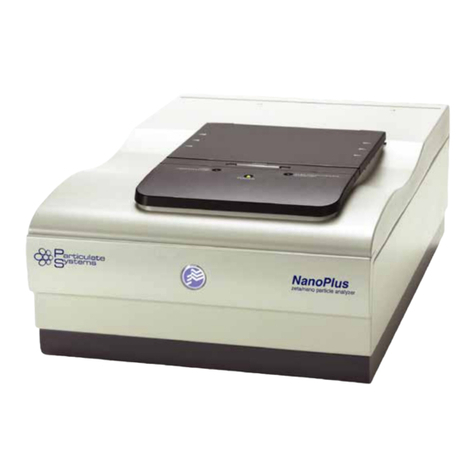
WARRANTY
Particulate Systems, a brand operating under MICROMERITICS INSTRUMENT CORPORATION, warrants
for one year from the date of shipment each instrument it distributes to be free from defects in material and
workmanship impairing its usefulness under normal use and service conditions except as noted herein.
Our liability under this warranty is limited to repair, servicing and adjustment, free of charge at our plant, of any
instrument or defective parts when returned prepaid to us and which our examination discloses to have been
defective. The purchaser is responsible for all transportation charges involving the shipment of materials for
warranty repairs. Failure of any instrument or product due to operator error, improper installation, unauthorized
repair or alteration, failure of utilities, or environmental contamination will not constitute a warranty claim. The
materials of construction used in products distributed by MICROMERITICS under the Particulate Systems
brand cannot be totally guaranteed against wear and/or decomposition by chemical action (corrosion) as a result
of normal use.
Repair parts are warranted to be free from defects in material and workmanship for 90 days from the date of
shipment.
No instrument or product shall be returned to MICROMERITICS prior to notification of alleged defect and
authorization to return the instrument or product. All repairs or replacements are made subject to factory inspec-
tion of returned parts. MICROMERITICS shall be released from all obligations under its warranty in the event
repairs or modifications are made by persons other than its own authorized service personnel unless such work
is authorized in writing by MICROMERITICS.
The obligations of this warranty will be limited under the following conditions:
1. Certain products sold by MICROMERITICS are the products of reputable manufacturers, sold under their
respective brand names or trade names. We, therefore, make no express or implied warranty as to such
products. We shall use our best efforts to obtain from the manufacturer, in accordance with his customary
practice, the repair or replacement of such of his products that may prove defective in workmanship or
materials. Service charges made by such manufacturer are the responsibility of the ultimate purchaser. This
states our entire liability in respect to such products, except as an authorized person of MICROMERITICS
may otherwise agree to in writing.
2. If an instrument or product is found defective during the warranty period, replacement parts may, at the dis-
cretion of MICROMERITICS, be sent to be installed by the purchaser, e.g., printed circuit boards, check
valves, seals, etc.
3. Expendable items, e.g., sample tubes, detector source lamps, indicator lamps, fuses, valve plugs (rotor) and
stems, seals and O-rings, ferrules, etc., are excluded from this warranty except for manufacturing defects.
Such items which perform satisfactorily during the first 45 days after the date of shipment are assumed to
be free of manufacturing defects.
Purchaser agrees to hold MICROMERITICS harmless from any patent infringement action brought against
MICROMERITICS if, at the request of the purchaser, MICROMERITICS modifies a standard product or man-
ufactures a special product to the purchaser’s specifications.
MICROMERITICS shall not be liable for consequential or other type damages resulting from the use of any of
its products other than the liability stated above. This warranty is in lieu of all other warranties, express or
implied, including, but not limited to, the implied warranties of merchantability or fitness for use.
4356 Communications Drive, Norcross, GA 30093
Fax (770) 662-3696
Domestic Sales - (770) 662-3633
Domestic Repair Service - (770) 662-3666
International Sales - (770) 662-3660
Customer Service - (770) 662-3636




























